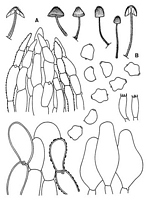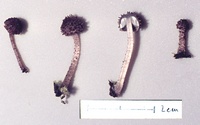|
 Cystoagaricus strobilomyces Cystoagaricus strobilomyces
SynonymsNolanea strobilomyces
BiostatusPresent in region - Indigenous. Non endemic
Images (click to enlarge) | 
Caption: ZT69-176
Owner: E. Horak: © Creative Commons Attribution-Noncommercial 3.0 New Zealand |
Article: Horak, E. (1980). Taxonomy and distribution of two little known, monotypic genera of Agaricales: Amparoina, Cystoagaricus. Sydowia 33: 64-70.
Description: Pileus 4-20(-30) mm, hemispheric, convex or umbonate-campanulate, becoming expanded with age; grey, dark brown or fuliginous; densely covered with minute, pointed, erect or recurved, concolorous spines, squarrose in centre, floccose to coarsely velutinous towards striate margin (in mature specimens), dry, veil remnants appendiculate in young carpophores along margin, soon vanishing. Lamellae (L 8-18, -3) adnate, adnexed or almost free, ventricose; grey at first changing to pale blue or bluish-pinkish, finally turning dark brown or black; margin denticulate-fimbriate, concolorous or dark brown. Stipe 5-40 x 1-2(3.5) mm, cylindric, central, equal or gradually tapering towards apex; grey to concolorous with pileus, whitish pruinose at apex, towards base covered with dark brown or black, scurfy scales or floccose-velutinous over whole length; dry, persistent cortina remnants absent, hollow, subcartilaginous, single in groups. Odour and taste not distinctive. Context: grey, turning black with age and on exposure. Chemical reactions on pileus: KOH—negative.
Spore print dark brown with purplish tint. Spores (5.5) 6-7.5 x (4) 4.5-6 µm, conspicuously mitriform (in dorso-ventral view), phaseoliform (in lateral view), grey to brown, opaque, smooth, membrane thin-walled, apical germ pore distinct. Basidia 18-28 x 5-7 µm, 4-spored. Cheilocystidia 20-50 (-75) x 12-25 µm, forming sterile seam on edge, clavate to vesiculose, usually thin-walled, but membrane also thickened (-2 µm diam.), hyaline or encrusted with brown membranous or encrusting pigment. Pleurocystidia 20-50 x 16-24 µm, scattered, clavate to lageniform, hyaline, thin-walled. Cuticle a trichoderm of fasciculate hyphae, cells cylindric or subfusoid (6-18 µm diam.), terminal cell conic, membrane not gelatinised, strongly encrusted with dark brown (exsiccata) or lilac (fresh material; KOH) pigment. Clamp connections numerous on septa.
Habitat: On well rotten or decayed wood and bark of trees.
Distribution: USA (Florida; type), Argentina, New Zealand, New Caledonia, Solomon Is., Papua New Guinea, Sabah (N. Borneo), Japan.
Notes: Recently SINGER (1973: 65) described a second species for the genus Cystoagaricus, C. jujuyensis (Argentina: Jujuy, Laguna de Yala, 10. II. 1966, leg. SINGER, T-5012, 21 (F)). The examination of the type material, however, proves that C. jujuyensis is not a representative of Cystoagaricus but a species which belongs either to Cystolepiota or Melanophyllum. Hence Cystoagaricus remains a monotypic genus within the Agaricales.
One of the most distinctive characters of C. strobilomyces are the mitriform, dark brown spores. It is of interest to point out that the first known collection of this agaric has been identified as "Inocybe" (New Zealand, 1919). The angular spores (in profile) also could be mistaken for those of Entoloma especially if microscopically checked with a low powered microscope. The usually distinct germ pore at the mucronate apex of the spores, however, immediately excludes both Inocybe and Entoloma.
Another remarkable feature of C. strobilomyces is the blue colour of the lamellae. The blue tint fades out rapidly with the ageing or drying of the material and therefore this character often goes unnoticed. Finally old or dried specimens completely turn black and exsiccata are reminiscent of Hydropus spp.
To present knowledge C. strobilomyces has a tropical-subtropical circumpacific distribution but the species occurs also in localities with more temperate climate both in the northern (Japan) and southern hemisphere (New Zealand).
According to the ecologic data reported for C. strobilomyces this fungus prefers as habitat rotten wood and bark of dicotyledonous trees (Nothofagus spp., Castanopsis sp., Piptadenia sp.). Thus far there is only one collection (ZT, 69/179, New Zealand) where this agaric formed fructifications on rotten wood of a conifer, viz. Dacrydium cupressinum (Podocarpaceae).
|